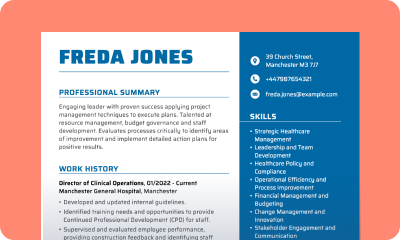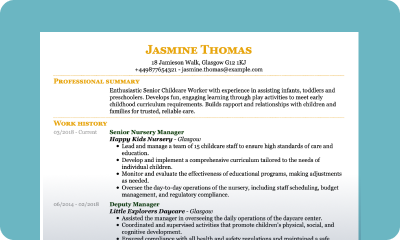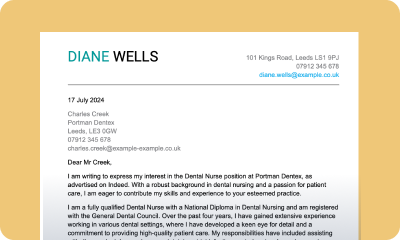- Our customers have been hired by : * Foot Note
Whilst work history is emphasised in many CV formats, in a skills-based CV, it’s your transferable skills that stand out. The skill-based CV format is ideal for candidates in many scenarios – including career changers and graduates.
This skills-based CV layout places your skills in centre stage, so recruiters can see the accomplishments that make you perfect for the role – along with your qualifications and voluntary experience too. Skills come straight after your personal statement with more detail added for each skill or category, making it more extensive than a typical skills list.
Whether you’re a fresh graduate looking for that perfect first job or you’re returning to work after maternity leave, this CV format can show employers everything you’re capable of – without focusing solely on work experience in the industry.
If you’re ready to get started on your CV, we have plenty of resources on hand to make the process extra easy. Get to grips with the structure of this format with a good example of a skills-based CV to show you how it’s done. Find out when you should use a skill-based CV format, along with some simple dos and don’ts. Then find answers to the most frequently asked questions for a skill-based CV.
Once you’ve read all our CV help and tips, you can choose from stylish CV templates to create a showstopping skills-based CV. Then let our online CV builder help you craft a professional skill-based CV – with plenty of fantastic pre-written content to take away the hassle.
SEARCH ALL CV EXAMPLES
What is the structure of the skills-based CV?
When writing a skills-based CV, you’ll need to ensure you include several core elements. Many of these elements are also included in a traditional CV format, but you will usually need to place them in a different order. A typical skills-based CV template will include your contact details, personal statement, skills, academic experience, work experience, and potentially your hobbies and other accomplishments.
Contact details
[This will be placed at the top of your skill-based CV. You’ll always need to include your full name, address, phone number and email address. If you have a LinkedIn page or a relevant social media page, you can also link this here. However, you should ensure it is professional and suitable for recruiters to view.]
Personal statement
[After your contact details comes your personal statement. This is a brief summary of who you are, what you have to offer, and the kind of role you’re looking for. You’ll need to tailor your personal statement to the job description, and – since this is a skills-based CV – make reference to the core skills you have that are relevant to the role.]
Skills
[This section is integral to this CV format, and is typically placed immediately after the personal statement, much higher than on other CV formats. You’ll need to include a bullet point list of skills that are relevant to the job description, and feature examples of how you’ve showcased these skills through your education or work. Taking a look at a skill-based CV sample for your industry can give you more ideas of the kinds of skills you’ll need to include.]
Education
[The way that you handle this section will ultimately depend on you. Fleshing out your education by including module details will be beneficial in a skills-based CV for a graduate with limited work experience. However, if your work or voluntary experience contains more relevant transferable skills, it would be better to keep this section short.]
Work history
[Your work history can come before or after your education section, depending on which you think will be more important to recruiters. You’ll need to keep this section short, only including the most relevant roles, with details of the title of the role, your starting and leaving dates, and key duties or achievements.]
Hobbies and interests
[You could choose to add a hobbies and interests section at the end, to showcase your passion for your chosen industry. Make sure it’s relevant to the job you’re applying for or the skills you’ve listed.]
Name: FREDA JONES
freda.jones@example example.co.uk | 07912345678 | 39 Church Street, Manchester M3 7J7
PROFESSIONAL SUMMARY
Friendly Trainee Nail Technician trained in both manicures and pedicures, an expert in nail design, extensions, and decorative effects. Hardworking, reliable, and dedicated to customer service. Willing to take on any task to support business and team needs.
SKILLS
Nail preparation
- Basic manicure, pedicure, and nail polish application techniques, using a combination of demonstration and practical time
Effective communication
- Excellent communicator with experience working in customer service roles assisting customers with requests (waitressing)
Health & safety
- Understands the health & safety, anatomy & physiology, client consultation and aftercare advice needed for these treatments.
- Cleaning tools at the end of the day with antibacterial products
- Safe handling of chemicals Nail art
- Application of a sculpting form, vamp and high C curve tips to create various on-trend nail shapes
- Application of pink, white & cover shades to extend nail beds, mask imperfections, ombré and perfect smile lines
- Creation of perfect social media images
Acrylic nails
- Tip application, product application, maintenance and removal of chosen system (gel or acrylic)
- Creation ballerina, Vamp, extreme square, almond and round shapes with perfect apex and C curves
EDUCATION
2021
Level 1 & 2 certificate: Nail Technology
High Ashleigh College | Manchester
2019
GCSE
Chorlton High School | Manchester
9 GCSE’s grades B-D
INTERESTS
- Latest fashion trends
- Modern art and nail designs
- Practicing nail art on friends and family to keep up training
- Instagram nail accounts
Skill-based CV format samples
If you want to see it all put into practice, take a look at our skills-based CV examples for UK roles. We’ve pulled together some top-rate samples for school leavers, skilled professionals, and career changes.
Sample 1 – Functional skills-based CV
In this skills-based CV example, the candidate has a range of technical skills to offer that are relevant to the role. Their qualifications and interests back up the various carpentry skills, showing that they’re ready for their first carpenter role.
Sample 2 – Transferable skills
For this candidate, a stylish skill-based CV template has put the focus on their various transferable skills upon leaving high school. From communication and teamwork to numerical and digital skills, the CV can be used to apply for a range of entry-level roles like waiter or administrative assistant.
Sample 3 – Career change
Not everyone has the career they want. In this instance, the candidate’s bartending experience isn’t as important as their various graphic design skills. Writing a CV with a skills-based template has put skills like digital design, photography, and branding strategies front and centre.
When to use a skill-based CV format
Not sure whether to write a skills-based CV vs a traditional CV? Ultimately, it will depend on your experience and the amount of time you’ve been out of work. Here are some examples of when you should submit a skills-based CV to a UK job application.
You’ve just finished school or university
Graduates know the struggle that comes with trying to get that first job. Utilising a skill-based CV template can make the process easier by showcasing your unique capabilities to employers. CV templates in other formats, such as chronological, are structured around your work history. If you have little to no work history, this type of format can keep your CV at the bottom of the pile, as it emphasises your lack of experience rather than your extensive education and skillset. Meanwhile, a skills-based CV places these strengths right in the line of employers’ sight.
You don’t have any industry experience
If you’re applying to jobs in a whole new industry, you might not have the level of industry experience that other candidates have. Choosing a skills-based CV for a career change is often the best option, because you can focus on your key competencies from your work, voluntary and academic history. With this CV format, you can highlight why you’re perfect for the role with skills that align with the person specification, without specific industry experience.
You’re returning to work after a gap
If you’re returning to work after a gap or maternity leave, you might be wondering which is a better option for you – a skills-based CV or chronological CV. There are several reasons why a functional or skills-based CV could be a better choice. For one thing, a chronological CV focuses on your work experience, drawing attention to the gap in your employment. It also could suggest that your industry knowledge may be outdated. By using a skills-based CV, you’re placing your skills, abilities and knowledge at the forefront, rather than highlighting the gap.
You want to turn a hobby into a career
If you’d like to take that interest or side-business into a fully-fledged career path, then a skill-based CV is likely to be the best choice. If you’ve made video content for years on end, but your current job is zookeeping, then a functional skills-based CV could showcase your abilities with more clarity. This type of CV is perfect for showing your dedication to a craft or creative career path – and you can also highlight your passion even further in your cover letter.
When not to use a skills-based CV format
It’s worth noting that candidates with plenty of relevant experience should not use the skills-based CV format. Recruiters generally prefer a reverse-chronological CV format, so they will be confused as to why your work history doesn’t come first without a good reason.
If you’re an office manager, for example, recruiters will care most about your experience in senior roles, the ways in which you’ve managed staff or resources, and some of the results you’ve delivered for previous employers. Similarly, as a primary school teacher, the time spent putting your training into practice, controlling classrooms and helping children progress will matter most. Or for a waiter job, recruiters will be more interested in specific roles where you’ve taken orders, handled cash, and built a rapport with customers, compared to simply listing those as skills you possess.
Put simply, experience is invaluable in the majority of roles, which is why reverse-chronological has become the predominant UK format. A skills-based CV should not be used when you have relevant experience to focus on and expand upon instead of your skills.
Download skills-based CV format by job
Whether it’s a career change, gap, or your first time applying for jobs, skills-based CVs can be used for a long list of different jobs. Thankfully, our CV builder is fully equipped with content based on an array of different roles for your skills, personal statement, and previous duties.
To give you a better idea, take a look at some skills-based CV examples for specific jobs below.
Dos and don’ts for the best skill-based CVs
From fresh graduates to skills-based CV for a career change, there are a few simple rules that apply across the board. Take a look a look at our dos and don’ts below and keep them in mind when writing your CV.
DO
DO: use a template
If you’re just getting to grips with the layout and requirements of this format, a skills-based CV template (UK) can make things a lot easier. It will ensure your CV looks the part, so you can focus on those all-important skills and other selling points in your education and personal statement.
DO: expand on your skills
In other CV formats, the skills list is very concise, with bullet points of your key skills and nothing more. For a skills-based CV, you’ll want to expand on them a little more with specific capabilities, qualifications, or examples to back up your ability. 2-4 points per skill or skill group is recommended.
DONT
DON’T: go overboard
Just because your CV is skills based, doesn’t mean you need to include every last skill you can think of. Try to narrow it down to your top 6-8 skills. Remember, you can group some skills together. “Time management” and “multi-tasking” can both come under the heading of “organization”, for example.
DON’T: pad out your CV
Skill-based CVs are typically shorter than other formats. But that doesn’t mean you should throw in unsuitable interests or skills to fill the page. Try tweaking your font size, line spacing, section spacing, and page margins instead. One page is the ideal length for this CV format.
Frequently asked questions about the skills-based CV format
What is a skills-based CV?
A skills-based CV is an alternative to the standard reverse-chronological format, which switches the focus from your work history to your skills. It comprises a larger section for your skills, which is more in-depth than a simple list. That section will appear further up the page, following your personal statement or professional summary.
How to write a skills-based CV for UK jobs
Here’s a typical skills-based CV layout:
- Contact details – Include your name, address, phone number, and email address, plus any relevant, professional social media profiles.
- Personal statement – Introduce yourself as an applicant in 2-4 sentences, highlighting some qualities that set you apart without simply repeating the skills section that will follow.
- Skills – Choose 6-8 key skills or skill groups and expand on them with bullet pointed examples, subskills, or qualifications that back them up.
- Work history – A brief summary of any previous roles with dates, location, and responsibilities. 3-6 duties per role is fine.
- Qualifications – List any relevant qualifications or academic achievements. For a skills-based CV, graduate candidates may want to expand on the details of their course, such as specific modules.
- Any additional sections – Whether it’s certifications, interests, or accomplishments, extra sections should come at the end of your CV.
When to use a skills-based CV?
Broadly speaking, the skills-based CV format is suitable when you’re lacking in experience. That could be down to:
- A career gap – because of parenthood, illness, or other circumstances.
- A career change – meaning your work history isn’t directly relevant.
- No experience – if you’re applying for your first job after leaving school, college, or university.
Remember that unrelated experience isn’t worthless. You can still focus on transferable skills, which could make a reverse-chronological CV work quite well. At the very least, it’s worth including that experience in your skills-based CV, albeit a little lower down.
Skill-based CV: key takeaways
The skill-based CV format can be invaluable for people who want to focus on their skills and capabilities rather than their experience (or lack of it). It takes the focus off your work history and puts you and your qualities in the limelight.
When writing a skills-based CV for UK roles, remember to cherry pick your best, most suitable skills based on the job description. Where possible, use a mix of hard (technical) skills and soft (transferable) skills to present yourself as a well-balanced character.
To make sure the formatting is right, it’s well worth using a skill-based CV template. This will include all the right sections with the correct structure and a suitable design. It will make it much easier to write your CV, giving you a strong foundation to build upon.
Don’t forget that general advice for writing a CV still applies, such as using keywords from the job description, keeping things concise, and using numbers to quantify any experience or achievements you do include.
Build your perfect skills-based CV format in 3 easy steps
- Choose a professionally designer CV format
- Add expertly written, tried-and-tested phrases
- Download your CV and apply!
*The names and logos of the companies referred to above are all trademarks of their respective holders. Unless specifically stated otherwise, such references are not intended to imply any affiliation or association with myperfectCV.



